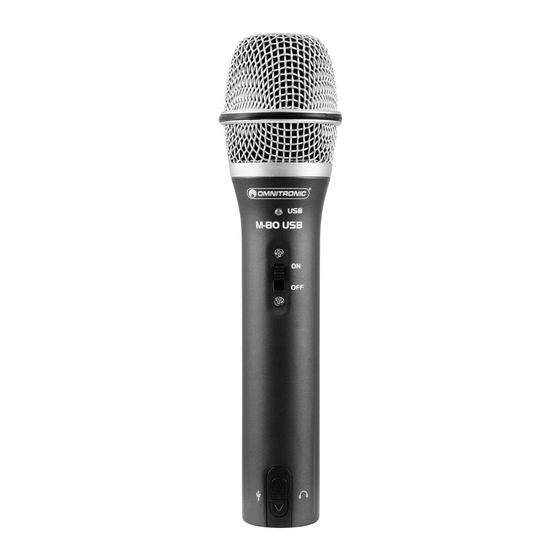
Inhaltszusammenfassung für Omnitronic M-80
- Seite 1 BEDIENUNGSANLEITUNG USER MANUAL M-80 USB MICROPHONE © Copyright Für weiteren Gebrauch aufbewahren! Nachdruck verboten! Keep this manual for future needs! Reproduction prohibited!
-
Seite 2: Inhaltsverzeichnis
Diese Bedienungsanleitung gilt für die Artikelnummer/This user manual is valid for the article number: 13000416 Das neueste Update dieser Bedienungsanleitung finden Sie im Internet unter: You can find the latest update of this user manual in the Internet under: www.omnitronic.com 00072256.DOC, Version 1.0 2/12... -
Seite 3: Einführung
M-80 USB-Mikrofon Einführung Das OMNITRONIC M-80 ist ein dynamisches Handmikrofon mit XLR- und USB-Anschluss für den Einsatz mit Mischpult und Computer. Es eignet sich perfekt zum Aufnehmen von Musik, Podcasts oder jeder anderen akustischen Audioquelle mit Ihrer DAW (Digital Audio Workstation). Der integrierte hochwertige Analog-Digital-Wandler erzielt mit einer Samplingrate von 16 Bit, 44,1 kHz/48 kHz erstklassige Klangqualität. -
Seite 4: Installation
(Abb. 4). • Die Tasten ▲ und ▼ am Mikrofon dienen ebenfalls zum Einstellen der Kopfhörerlautstärke. • Wenn Sie statt dem M-80 eine der Soundkarten Ihres (Abb. 3) Computers als Ausgabegerät anwählen, regeln die Tasten ▲ und ▼ die Lautstärke der Soundkarte. -
Seite 5: Erste Schritte Mit Windows 7
Lautstärkeeinstellung (Abb. 10). • Die Tasten ▲ und ▼ am Mikrofon dienen ebenfalls zum Einstellen der Kopfhörerlautstärke. • Wenn Sie statt dem M-80 eine der Soundkarten Ihres Computers als Ausgabegerät anwählen, regeln die Tasten ▲ und ▼ die Lautstärke der Soundkarte. -
Seite 6: Erste Schritte Mit Mac Os X
Mikrofons einzustellen (Abb. 13). • Die Tasten ▲ und ▼ am Mikrofon dienen ebenfalls zum Einstellen der Kopfhörerlautstärke. • Wenn Sie statt dem M-80 eine der Soundkarten Ihres Computers als Ausgabegerät anwählen, regeln die Tasten ▲ und ▼ die Lautstärke der Soundkarte. -
Seite 7: Allgemeine Bedienschritte
Allgemeine Bedienschritte Nehmen Sie das M-80 aus der Verpackung. Stellen Sie das Tischstativ auf und klemmen Sie das Mikrofon in die Halterung. Stellen Sie den Schiebeschalter auf ON, um das Mikrofon einzuschalten. Richten Sie das Mikrofon direkt auf die Schallquelle. -
Seite 8: Introduction
M-80 Microphone Introduction The OMNITRONIC M-80 is a dynamic handheld microphone with XLR and USB outputs for use with mixing consoles and computers. It is perfect for recording your music, podcast or an acoustic audio source on your DAW (Digital Audio Workstation). With a sampling rate of 16 bits, 44.1 kHz and 48 kHz, the integrated high- resolution analog-to-digital converter provides high-end audio quality. -
Seite 9: Installation
Installation Use the included USB cable to connect the M-80 to an available USB port on your computer. The microphone is compatible with both PC and Mac computers and is plug and play. You can control the M-80 using the standard audio (Fig. -
Seite 10: First Steps With Windows 7
The first time you connect the microphone to a USB port it will be recognized as a USB audio device under the name “OMNITRONIC M-80“ and Windows 7 will install the universal drivers. Windows 7 will display a notification informing you that the hardware was successfully installed. -
Seite 11: First Steps With Mac Os X
System Preferences from the dock or the main Apple Menu. Open the Sound preference (fig. 11). Click the Input tab and select M-80. To set the gain of the microphone, adjust the Input volume slider (fig. 12). (Fig. 11) Click the Output tab and select M-80. -
Seite 12: Basic Operation
For live sound applications, the M-80 can also be connected to a standard mixing console. For this, connect the microphone via an XLR cable to the XLR microphone input of your audio unit.















